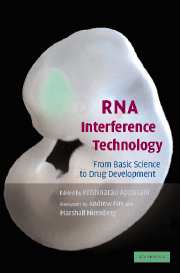Book contents
- Frontmatter
- Contents
- Foreword by Andrew Fire
- Foreword by Marshall Nirenberg
- List of Contributors
- Introduction
- Section one Basic RNAi, siRNA, microRNAs and gene-silencing mechanisms
- 1 RNAi beginnings, Overview of the pathway in C. elegans
- 2 Dicer in RNAi: Its roles in vivo and utility in vitro
- 3 Genes required for RNA interference
- 4 MicroRNAs: A small contribution from worms
- 5 miRNAs in the brain and the application of RNAi to neurons
- Section two Design, synthesis of siRNAs
- Section three Vector development and in vivo, in vitro and in ovo delivery methods
- Section four Gene silencing in model organisms
- Section five Drug target validation
- Section six Therapeutic and drug development
- Section seven High-throughput genome-wide RNAi analysis
- Index
- Plate section
- References
3 - Genes required for RNA interference
Published online by Cambridge University Press: 31 July 2009
- Frontmatter
- Contents
- Foreword by Andrew Fire
- Foreword by Marshall Nirenberg
- List of Contributors
- Introduction
- Section one Basic RNAi, siRNA, microRNAs and gene-silencing mechanisms
- 1 RNAi beginnings, Overview of the pathway in C. elegans
- 2 Dicer in RNAi: Its roles in vivo and utility in vitro
- 3 Genes required for RNA interference
- 4 MicroRNAs: A small contribution from worms
- 5 miRNAs in the brain and the application of RNAi to neurons
- Section two Design, synthesis of siRNAs
- Section three Vector development and in vivo, in vitro and in ovo delivery methods
- Section four Gene silencing in model organisms
- Section five Drug target validation
- Section six Therapeutic and drug development
- Section seven High-throughput genome-wide RNAi analysis
- Index
- Plate section
- References
Summary
Introduction
RNA interference (RNAi) is a recently discovered phenomenon in which double-stranded RNA (dsRNA) silences endogenous gene expression in a sequence-specific manner (Fire et al., 1998). Since its discovery, the use of RNAi has become widely employed in many organisms to specifically knock down gene function. RNAi shares a remarkable degree of similarity with silencing phenomena in other organisms (Cogoni et al., 1999a; Sharp, 1999). For instance, RNAi, post-transcriptional gene silencing in plants and cosuppression in fungi can all be activated by the presence of aberrant RNAs (Maine, 2000; Tijsterman et al., 2002a). Additionally, plant, worm, and fly cells or extracts undergoing RNA-mediated interference all contain small dsRNAs, around 25 nucleotides in length, identical to the sequences present in the silenced gene (Baulcombe, 1996; Hammond et al., 2000; Zamore et al., 2000; Catalanotto et al., 2000).
The high degree of similarity between these RNA-mediated silencing phenomena supports the notion that they were derived from an ancient and conserved pathway used to regulate gene expression, presumably to eliminate defective RNAs and to defend against viral infections and transposons (Zamore, 2002). Components of RNAi have also been implicated in developmental processes, suggesting that RNAi may play a broader role in regulating gene expression (Smardon et al., 2000; Knight et al., 2001; et al., Ketting et al., 2001).
Although we have learned much about the general mechanisms underlying RNAi, a detailed understanding of how RNAi works remains to be elucidated.
- Type
- Chapter
- Information
- RNA Interference TechnologyFrom Basic Science to Drug Development, pp. 55 - 68Publisher: Cambridge University PressPrint publication year: 2005
References
- 1
- Cited by



